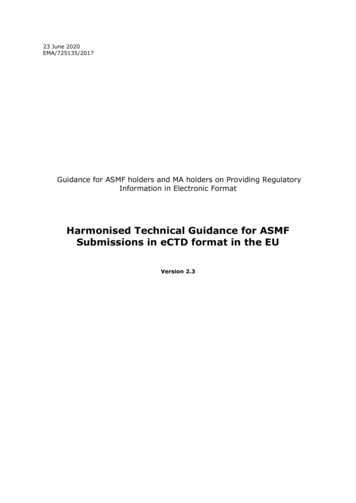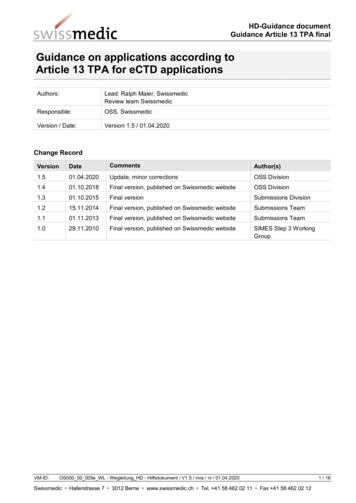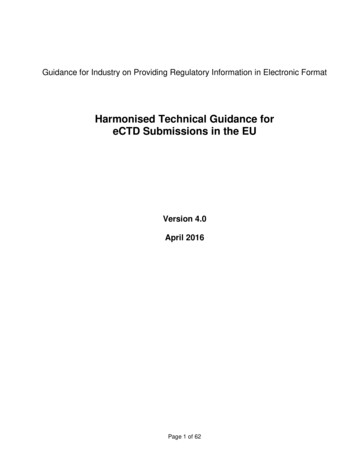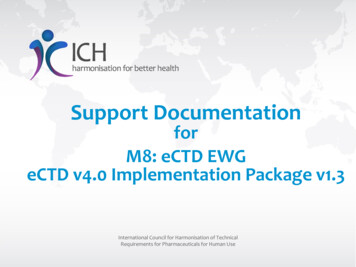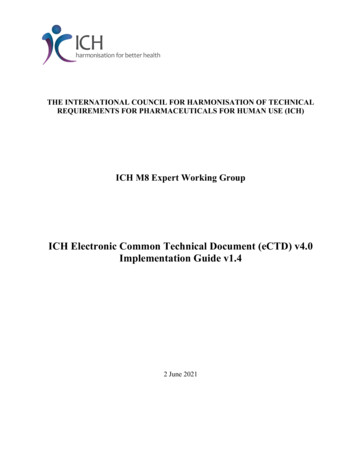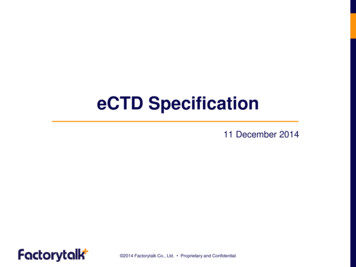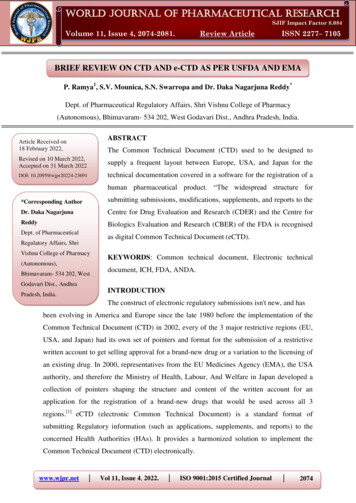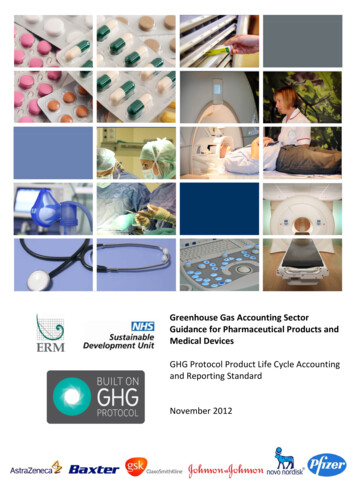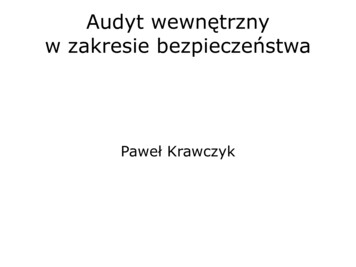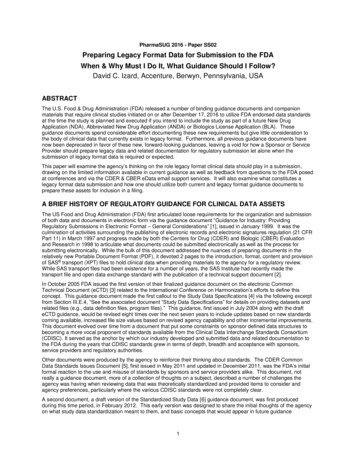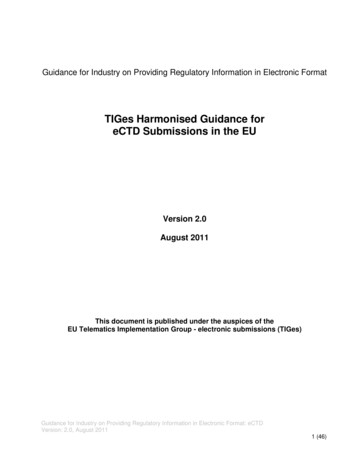
Transcription
Guidance for Industry on Providing Regulatory Information in Electronic FormatTIGes Harmonised Guidance foreCTD Submissions in the EUVersion 2.0August 2011This document is published under the auspices of theEU Telematics Implementation Group - electronic submissions (TIGes)Guidance for Industry on Providing Regulatory Information in Electronic Format: eCTDVersion: 2.0, August 20111 (46)
Table of Contents1. INTRODUCTION . 31.1Glossary. 42. GENERAL CONSIDERATIONS . 52.1Scope . 52.2Structure of Submissions . 52.3Transitional Arrangements . 62.4Moving to eCTD Format from Paper or NeeS Type Applications. 62.5General Submission Considerations . 72.6Correspondence . 72.7Paper Requirements. 72.8Hardware . 82.9General Technical eCTD Information. 82.10Other Technical Information . 132.11Number of Media Requested . 152.12Technical Baseline Applications . 153. MODULE SPECIFIC INFORMATION. 193.1General Information . 193.2Module 1 eCTD Envelope, Administrative Information and Prescribing Information Folder . 193.3Module 2 Overviews and Summaries Folder . 213.4Module 3 Quality Folder . 223.5Module 4 Nonclinical Study Reports Folder . 223.6Module 5 Clinical Study Reports Folder . 224. ADVICE ON SPECIFIC APPLICATION TYPES . 244.1Initial MA Applications. 244.2Variation Applications . 254.3Extension Submissions . 264.4Renewal Submissions . 264.5PSURs . 274.6MRP and DCP Applications. 274.7Referrals . 274.8Active Substance Master Files . 284.9Vaccine Antigen Master Files . 284.10Plasma Master Files . 284.11Applicant Initiated Withdrawals . 294.12Duplicate Applications . 29ANNEX 1: ECTD REFERENCE DOCUMENTS . 30ANNEX 2: GUIDANCE ON TEXT SEARCHABLE DOCUMENTS . 31A2-1General . 31A2-2Documents that Must Always Be Text Searchable . 31A2-3Documents that Do Not Need to Be Text Searchable . 32A2-4.Further Information . 32ANNEX 3: GUIDANCE AND BEST PRACTICE ON THE STRUCTURE OF MODULE 3 . 33A3-1.Introduction . 33A3-2General Principles . 33A3-3Module 3 XML Attributes in the eCTD . 36Guidance for Industry on Providing Regulatory Information in Electronic Format: eCTDVersion: 2.0, August 20112 (46)
1.INTRODUCTIONThis guidance document is intended to assist pharmaceutical companies with the submission of regulatoryinformation in electronic Common Technical Document format (eCTD) to the National Competent Authorities(hereafter referred to as NCAs) and the European Medicines Agency (hereafter referred to as EMA). The eCTDformat is regarded as the principal electronic submission format in EU and is the only electronic format that isaccepted by the EMA. However, the Non eCTD electronic Submissions (NeeS) format is also accepted by mostNCAs and therefore a guidance document for NeeS has been published on the EMA eSubmission website aswell.The guidance has been created by the TIGes Harmonisation Group, a sub-group of the TelematicsImplementation Group for electronic submissions (TIGes), and has been adopted for publication by the TIGes.It should be stressed that this guidance reflects the current situation and will be regularly updated in the light ofchanges in national and/or European legislation together with further experience gained within NCAs of usinginformation submitted in electronic format.This document consists of four parts: Introduction, General Considerations, Module Specific Information andAdvice on Specific Application Types together with associated annexes.Guidance for Industry on Providing Regulatory Information in Electronic Format: eCTDVersion: 2.0, August 20113 (46)
1.1GlossaryA brief glossary of terms (for the purpose of this document only) is indicated below:TermDefinitionApplicantA pharmaceutical company or its agent that is submittinginformation in support of an application.Applicant’s informationRegulatory information submitted by an applicant for, orto maintain, a marketing authorisation that falls within thescope of this guidance document.eCTD applicationA collection of electronic documents compiled by apharmaceutical company or its agent in compliance withEuropean legislation and guidelines in order to seek amarketing authorisation or any amendments thereof. AneCTD application may comprise a number ofsequences. In the EU an eCTD application may compriseseveral dosage forms and strengths, all under oneinvented product name. Some review tools describe sucha collection as a dossier.ProcedureA Community registration procedure for the authorisationof medicinal products in the European Community. Thereare 4 types of procedure that operate within the EC –Centralised, Decentralised, Mutual Recognition andNational.Submission or SequenceA single set of information and/or electronic documentssupplied at one particular time by the applicant as a partof, or the complete, eCTD Application. In the context ofeCTD, this is equivalent to a sequence.Regulatory activityA collection of sequences covering the start to the end ofa specific business process, e.g. an initial MA applicationor Type II variation. It is a concept used in some reviewtools to group together several business relatedsequences.Guidance for Industry on Providing Regulatory Information in Electronic Format: eCTDVersion: 2.0, August 20114 (46)
2.GENERAL CONSIDERATIONS2.1Scope2.1.1Types of ProductThis guidance covers the submission of electronic regulatory information for all human medicinal productsfalling within the competence of NCAs in the EEA as well as the EMA. This includes prescription, over thecounter medicines, innovative and generic product submissions. The product types include small molecules,biotech products, herbals, vaccines, homeopathics and blood products.2.1.2Types of SubmissionThis guidance applies to all submissions related to the authorisation and maintenance of medicinal products,including new marketing authorisations, variations, renewals, PSURs, active substance master files (ASMF)and Plasma Master Files (PMF). For variations, ASMF and PMF there are also specific guidance documents(see references in Part 4).2.1.3Types of ProceduresThis guidance covers applications made in any of the applicable Community procedures (National, MutualRecognition, Decentralised and Centralised).2.1.4ExceptionsThis guidance does not apply to the electronic submission of pre-MA information such as scientific advice,clinical trial applications, Orphan drug designations, PIP submissions and related submission correspondence.2.2Structure of SubmissionsThis document provides guidance on how to organise application information for electronic submission usingthe eCTD specifications. Guidance on the detailed information to be included is described in the CommonTechnical Document (CTD), and relevant ICH and EU Q&A documents.The structure and organisation of an eCTD submission is defined by the following standards: ICH M2 eCTD SpecificationEU Module 1 SpecificationRelevant ICH and EU Q&A docsAnnex 1 contains links to the currently approved version of these documents.Typically, an eCTD application will cover all dosage forms and strengths of a product. In the centralisedprocedure, this will be equivalent to all dosage forms and strengths covered by an EMA application number(e.g. EMEA/H/C/123). In MRP/DCP, a single eCTD application should preferably be used for the procedure.However if an applicant decides not to apply for all strengths and dosage forms in every member state in theprocedure, the possibility of having one eCTD application per strength/dosage form should be considered.Applicants should carefully consider what an eCTD application should cover before submitting the firstsequence, as the choice could have implications for workload for the lifespan of the product. For example, ifthe applicant decides to have one eCTD per strength or dosage form, it is expected that each of these eCTDapplications will be maintained individually, such that submission of a single sequence that covers more thanone strength or dosage form will no longer be possible if very good reasons are not presented for a changeover. In these rare cases, please contact the NCA/RMS/EMA concerned at an early planning stage.For further details on the pros and cons of the different approaches to dossier structure, see Annex 3, Table 1.Please check for specific NCA guidance when preparing national eCTDs.Guidance for Industry on Providing Regulatory Information in Electronic Format: eCTDVersion: 2.0, August 20115 (46)
2.3Transitional ArrangementsThe specifications mentioned in section 2.2 above will change over time and are likely to affect both eCTDbuilding tools and the applicant’s internal business processes as well as the agencies review tools andprocesses. Once a new specification has been agreed and endorsed by the appropriate EU body, eCTDbuilding tools will need to be updated. Specific transitional guidance will be provided on each occasion that theICH and/or EU specifications are updated.Please note that it should not be necessary to reformat and resubmit previously submitted applications toreflect such changes.2.4Moving to eCTD Format from Paper or NeeS Type ApplicationsChanging format from paper or NeeS to eCTD can be done at a start of any regulatory activity such as anextension, a renewal or a variation, ideally when no other regulatory activities are ongoing for that product inanother format. A baseline submission is recommended at the time of changing to eCTD (see section 2.12.)When the eCTD lifecycle is initiated and accepted by the authorities, all further submissions related to thatproduct dossier should from that day be submitted in eCTD format. This may also include submissionsconcerning other ongoing regulatory activities related to that eCTD application (e.g. responses to questions toongoing variations), in which case, it will obviously not be possible to use the related sequence attributecorrectly since the start of the regulatory activity is not present as an eCTD sequence to refer to and thereforethe validation criterion 14 BP1 will not be met. This should be reflected in the cover letter.If the dossier has already been provided in NeeS format, you should submit the new data in eCTD formatstarting the lifecycle in accordance with eCTD specifications. The first submission in eCTD format will normallybe sequence 0000, even if sequential numbers were used for the NeeS format. As the documents already existin an electronic format, it would be preferable to first re-send the currently valid documents, especially module3, as a baseline eCTD dossier in sequence number 0000 and then the first new regulatory activity as 0001. Inthat case, the submission type reformat should be used in the envelope for the 0000 sequence. This is alsoapplicable when changing from paper, but might mean that the current valid documents are provided asscanned documents when this kind of baseline is submitted (further recommendations can be found in Annex2). For clarity, you should always explicitly state in the cover letter that you want to switch to eCTD format.Please see section 2.12 for further information on the content of baseline applications and the acceptability ofscanned document.In the case, you have for some time submitted applications in eCTD format to some agencies within MRP orDCP when paper or NeeS were still requested by some other NCAs, these remaining agencies would now bepleased to receive all former sequences when switching to eCTD format in connection to a new regulatoryactivity for that product. The “old” eCTD sequences should be provided together with this new eCTD sequenceand it should be clearly stated in the cover letter to the concerned NCAs that the “old” sequences have thesame content as formerly submitted paper or NeeS format documents. When submitting earlier sequences toother agencies, no changes to envelopes or metadata is required, it is accepted that the envelopes might notbe entirely correct for agencies receiving a sequence previously submitted to another agency. Any historicalsequences should not be technically validated by the agencies receiving them for the first time, for details seethe CMDh BPG for eCTD in MRP and DCP. However, if there are problems with loading or reading the “old”files, the applicant should assist in solving the technical problems on the sequences to facilitate their use in the“new” NCA, for example due to mistakes in burning or problems with the XML, which can be resolved withoutaffecting future lifecycle.In any case, a tracking table is essential to understand the sequencing of your eCTD submission (please referto section 3.2.3).Where the change from paper or NeeS to eCTD format for a product dossier is planned to be done inconnection to a repeat use procedure (i.e. for the complete dossier), the change of format should first be madein the RMS and the “old” CMSs by submitting the current dossier as a so called baseline dossier (see section2.12), before the start of the repeat use procedure in the new CMSs.Guidance for Industry on Providing Regulatory Information in Electronic Format: eCTDVersion: 2.0, August 20116 (46)
2.5General Submission Considerations2.5.1Document GranularitySubmissions are a collection of documents and each document should be provided as a separate file. Thedetailed structure of the eCTD should conform to the ICH Granularity Document and EU M1 specifications.Careful consideration is needed when deciding the level of Module 3 granularity (please refer to Annex 3,section 3.1)2.5.2File NamingThe eCTD file naming conventions described in the ICH M2 eCTD Specification and EU Module 1Specification are highly recommended, as best practice. If an applicant wishes to submit multiple files in onesection, where only one highly recommended name is available, this can be achieved using a suffix to thefilename, using the file name-var.pdf convention as described in the EU Module 1 Specification (e.g.pharmaceutical-development-container.pdf). Also the variable part of the name must not contain “illegal”characters.File names, including the extension, must not exceed 64 characters. Also folder names must not exceed 64characters and the total file folder path length must not exceed 180 characters. Counting starts from the firstdigit of the sequence number in the sequence number folder name.For further guidance on file naming, please refer to the “File-Folder Structure & Names” work sheet included inthe eCTD Validation Criteria version 3.1.2.5.3Placement of DocumentsGuidance on the placement of documents within the eCTD structure for particular submission types can befound in the EU-CTD Notice to Applicants and/or in the EMA post-authorisation guidance for centralisedapplications.In the submission structure, leaves may only exists at the lowest level of the CTD structure. Also, the lowestlevels (including node-extensions) must contain at least one leaf.Every leaf must have a value for the ‘title’ attribute.2.6CorrespondenceThe eCTD is designed to ensure that users have a current view of the information submitted in the appropriateplace in the dossier at all times. Therefore, formal responses to questions should always be submitted in eCTDformat, as well as any correspondence that relates directly to the content of the dossier.In addition to the eCTD application, information may need to be exchanged to assist the processing or handlingof the application. Not all that correspondence should be included in the eCTD. This is because the eCTDexchange is currently one way only, from applicant to authority, and not all correspondence is directly relevantto the application dossier. This additional, other correspondence should be exchanged outside the eCTD viathe usual electronic means (email, Eudralink etc).2.7Paper RequirementsIn general, electronic submissions should be accompanied by an original signed application form and coverletter, but there can be exceptions from this in some NCAs. Detailed information on each NCA’s specificrequirements can be found at the CMDh website and/or websites of the individual NCA.Please note that the EMA requests the original signed hard copy of the cover letter together with the CD/DVD.The signed scanned application form should only be provided within the eCTD sequence.Guidance for Industry on Providing Regulatory Information in Electronic Format: eCTDVersion: 2.0, August 20117 (46)
Guidance on the minimum requirements to produce a paper submission from an eCTD has also beenpublished see - “Practical Guidance For the Paper Submission of Regulatory Information in Support of aMarketing Authorisation Application When Using an eCTD or a NeeS as the Source Submission.”2.8HardwareNCAs and the EMA will not accept any hardware (laptops, desktops, zip drives, etc.) from applicants inconnection with the submission of information in electronic format. The electronic information should be directlyreadable and usable on NCAs and EMA hardware and software.2.9General Technical eCTD Information2.9.1File FormatsIn general terms the majority of documents included in electronic submissions should be in PDF format (seenext section on the use of PDF file versions). Files that might be requested by NCAs in MS Word or RTF formatshould not be included in the eCTD structure (refer to 2.9.9.).The use of XML for application forms in particular is likely to increase as agency systems develop thefunctionality to handle it in their own business processes. See Section 3.2.4 for further information.Further detailed guidance on file formats can be found in the ICH eCTD specification document and EU Module 1specifications.2.9.2Portable Document Format (PDF)Portable Document Format (PDF) is an open, de facto, electronic publishing standard. Although created byAdobe Systems Incorporated there are several alternative suppliers of PDF software. Applicants need to checkthat their PDF documents meet the following key requirements: Files should be legible with Acrobat Reader, version 5.0 or higher.PDF file version 1.4 or 1.7 should normally be used, except where there is an agency specific requirementfor another version for example for application forms.PDF 1.3 or earlier versions are not acceptable for technical reasons. No exceptions will be made. Forexample, if a literature reference is received in PDF 1.3 or earlier, then the applicant must convert it to PDF1.4 or 1.7.If the use of other versions of PDF is unavoidable then the applicant should explain the reason for it in thecover letter/explanation note as it is not in line with the Best Practice validation.Documents generated by the applicant should be created from electronic source documents and not fromscanned material. Where access to the source electronic file is unavailable please refer to Annex 2.Normally, for the application form and cover letter, there is no requirement to scan wet signatures. Thesignature could in these cases appear only on the paper copy. However, the EMA and some NCAs dorequire that wet signatures are scanned – for details refer to national guidance.Additional details on PDF, including those relating to the good presentation of tables, can be found in the ICHeCTD Specification, Appendix 7.2.9.3Sequence NumbersSequence numbers are used to differentiate between different submissions of the same application over thelifecycle of the product. The review tools being used by most NCAs and the EMA are able to handle sequencessubmitted out of numerical order, i.e. 0003 submitted after 0004. This can occur when the preparation of asequence is delayed. However, it is recommended that sequence numbers should normally follow the order ofsubmission of the sequences. A Sequence Tracking Table should always be included as an annex to the coverletter in every submission within MRP/DCP (see CMD(h) recommendations on the cover letter). Specificrecommendations for MR and DC Procedures are given in the CMDh BPG for eCTD in MRP and DCP.Guidance for Industry on Providing Regulatory Information in Electronic Format: eCTDVersion: 2.0, August 20118 (46)
A similar tracking table is recommended for national applications and also for applications through theCentralised Procedure. (This is to ensure that gaps are avoided in the lifecycle management and to inform themember states about possible ongoing procedures that are handled by the EMA.)The initial eCTD lifecycle submission should normally have a sequence number of 0000, even if sequentialnumbers were already used for a NeeS format of the same product. If applicants consider that there are goodreasons to use another number they should explain this in the cover letter.When additional information is submitted in response to questions or when information in a previouslysubmitted sequence is modified in any way, the sequence number of the submission will advance, 0001, 0002,etc. Only in the case of a technically invalid submission, at request from or agreement with the EMA (CP) or anNCA (MRP/DCP/NP), a sequence can be replaced with another using the same number (e.g. the initialsequence “0000” will be replaced by another “0000”). The new sequence should be sent to all concernedauthorities. No new documents may be included in these cases, but only technical problems should be fixed.The reason for resending the same sequence must be clearly stated in a paper note included in the packagecontaining the submission (e.g. a hand written note on the paper copy of the original cover letter). If the eCTDneeds to be updated due to content/regulatory validation, any revised content should be provided with a newsequence number and the changes clarified in the cover letter.2.9.4Related SequenceThe relationship of one sequence to another is managed using the related sequence number. This allowssequences to be grouped together that make up an application or a Regulatory Activity.For a new Regulatory Activity, the appropriate submission type should be used. Applicants should refer to thesubmission type descriptions in the EU Module 1 specification. For the sequence that initiates a RegulatoryActivity ‘supplemental-info’ and ‘corrigendum’ must not be used.The submission type ‘supplemental-info’ should be routinely used for all subsequent sequences until theconclusion of the Regulatory Activity. The submission type ‘corrigendum’ should only be used in exceptionalcircumstances to correct information, typically for product information in the CP, after the Regulatory Activityhas concluded.Only the submission types ‘supplemental-info’ and ‘corrigendum’ should have related sequences.Tables 1, 2 and 3 provide examples of this convention.Table 1: Example of an initial MAA in the Centralised ProcedureSequenceSubmission DescriptionSubmission Typenumber0000Initial MAAinitial-maa0001Validation updatesupplemental-info0002Day 121 responsessupplemental-info0003Day 181 responsessupplemental-info0004Final translations of productsupplemental-infoinformation (Decision)0005Correction of errors in Danish productcorrigenduminformation after DecisionTable 2: Example of an initial MAA in the Decentralised ProcedureSequenceSubmission DescriptionSubmission Typenumber0000Initial MAAinitial-maa0001Validation updatesupplemental-info0002Day 106 responsessupplemental-info0003Day 180 responsessupplemental-info0004Day 210 Agreed English productsupplemental-infoinformationRelated Sequencenone00000000000000000000Related Sequencenone0000000000000000Guidance for Industry on Providing Regulatory Information in Electronic Format: eCTDVersion: 2.0, August 20119 (46)
Table 3: Example of a VariationSequenceSubmission Descriptionnumber0008Variation for new indication of COPD0009Validation update0010Responses to questionsSubmission TypeRelated onone00080008It is generally expected that there is usually just one Related Sequence, but, there are some occasions wheremore than one Related Sequence should be provided as for example:1) When there are two FUMs (sequence 0005 and sequence 0006) and a single response (sequence0007) is produced that relates to both FUMs.2) When there are two parallel variations (sequence 0002 and sequence 0003) and there is a sequence(0004) that brings the label up to date by including the changes made in both variations.On these occasions multiple related sequences are used, but if a subsequent sequence relates to only one ofthe original regulatory activities, then only the related sequence for that particular regulatory activity should beusedIf the related sequences refer to both a single and grouped variation, the metadata should state ‘grouped’ asbeing the highest level of regulatory activity.2.9.5Leaf Lifecycle OperationsThe leaf lifecycle operation attributes, as stated in the eCTD Specifications, are ‘new’, ‘append’, ‘replace’ and‘delete’. However, in the EU, it is recommended that applicants avoid the use of ‘append’ due to the potentialfor increased lifecycle complexity.In general, leaf lifecycle operations cannot take place between leaf elements in different CTD sections. E.g. aleaf to be submitted in Module 4.2.2.5 in Sequence 0012 cannot replace/delete a leaf submitted in Module4.2.2.2 of Sequence 0010.This applies across all of the modules of the CTD and is not specific to either the regional or ICH Modules.One scenario where leaf lifecycle operations between different CTD sections must not be used is to “correcterrors” in the placement of content in the submission structure. If the applicant company places content in thewrong CTD section and needs to correct this (either upon request from the agency receiving the eCTD orbecause they wish to correct the mistake) th
When the eCTD lifecycle is initiated and accepted by the authorities, all further submissions related to that product dossier should from that day be submitted in eCTD format. This may also include submissions concerning other ongoing regulatory activities related to that eCTD application (e.g. responses to questions to
